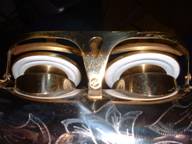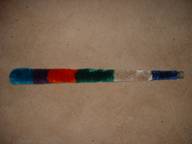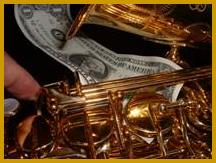

|
SaxophoneMan.com |

|
All Things Saxophone |
|
Equipment Fundamentals — Pads |
|
Last modified 09/12/08
|
|
Questions or comments? Send us an email |

|
The pads on a saxophone are installed and seated at the factory and should not be adjusted or replaced by a player unless he/she has had training in pad adjustment & replacement. However, pads do wear out so a saxophonist should have a basic understanding of pad construction, selection and care so as to know when to take the horn into the shop and also to avoid a "B.S." treatment from a repair person that doesn't know what they are doing. · Pad construction Saxophone pads are made of a cardboard or poster board base, a cushioned inner layer, a leather cover and a small disc called a resonator (made of plastic, nickel or brass) in the center. The resonator is shaped something like a big thumb tack. The shaft of the resonator is used to secure the pad in place. Saxophone pads are NOT made of cloth like flute & clarinet pads -- don't let anybody convince you to allow a cloth pad to be installed on your saxophone! In rare cases (like my Super20 Alto), cork pads can be used on small tone holes like octave keys where sticky pads are a problem, and cork is always used on spit valves (on the baritone sax). Being a big sound guy, I prefer the pads with the kangaroo leather and big brass resonators. Whatever you use, make sure the pads are CONSISTENT throughout the horn. Don't let a repair person put a pad with a different kind of leather or resonator on your horn unless you intend to re-pad the entire instrument with that pad type. Also, make sure that the pad is the correct size for the tone hole. · When is a pad worn out? The best way to determine if a pad is worn out is to look at the color and feel the texture of the leather. Over time, moisture on the pad causes the leather to discolor and get hard and/or brittle. This usually results in leaks. If your horn feels like it has a leak, this is probably because of a pad that is out of adjustment, poorly seated or bad. If so, get the pad adjusted or replaced. · Caring for your pads Keep the moisture on the pads under control. Moisture is bad for pads but is an inevitable part of playing the instrument. Place a "sax stuffer" in the body of your horn (for Soprano, Alto, & Tenor saxes) whenever you put it away. This accessory "wicks" the moisture away from the pads, increasing pad life. Also, use pad clamps to keep the pads closed when you pack the instrument away. These clamps hold the pads in place so they retain their proper seating. Since the layout of every saxophone is different, be sure that you get pad clamps that are designed specifically for your make and model of saxophone. · Sticky pads Sometimes a pad will get a little sticky due to dirt, oil & moisture buildup on the surface of the pad. Most of the time you can fix that with a crisp bill ($1, $5, $10, etc. -- it doesn't matter). Just follow the procedure below:
Open the pad if it isn’t one that is open in the default position
place a corner of the bill between the pad and the tone hole, covering the tone hole completely
close the pad & hold it closed
gently pull the bill out -- this will wipe the pad clean A little knowledge of saxophone pads goes a long way. Keeping these concepts in mind will help you keep those pads doing what they do best — making music.
|

|
Kangaroo leather pads with the big brass resonators |

|
A “sax stuffer” |

|
Pad clamps keep the pads properly seated in storage |



